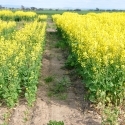11 Nov 2014
Canola 4R Nutrient Management
Lessons from Australia, US Canola Association Research Conference.

Canola 4R nutrient management – lessons from Australia
Presented at the US Canola Associate Research Conference, Long Beach California, November 2014.
Canola is Australia’s the third largest grain crop behind wheat and barley. In 2014 2.29 Mha were planted with a production potential of 3.3 Mt, down on the 2012 record of 4.1 Mt.
In estimating the fertiliser demand, growers shallow and deep soil tests, field cropping history, plant testing for nutrient status, balance sheets based on nutrient removal, and test strips in fields. These tools, used in combination, assist growers select the best rate and time for in a nutrient management plan for a high yielding canola crop.
Other than sulfur, the overall nutrient demands of canola are similar to the spring wheats produced in Australia and growers usually apply P as MAP/DAP at seeding (10 kg P/ha). Potassium is not commonly used on states other than Western Australia.
Liming and the use of gypsum – often together before seeding are common practices on acid soils, and the use of lime has been implicated in reduced boron availability. Other than boron, there is little evidence of zinc, copper, manganese or molybdenum responses where soil pHCa is above 5.5 Canola seems better able to access copper and zinc than cereals.
The two key nutrients are nitrogen and sulfur, which are managed tactically in response to seasonal conditions. Even though the sulfur requirement of canola is higher than wheat, sulfur responsive sites are not common but sulfur fortified MAP is often used at seeding, or ammonium sulfate applied at stem elongation.
Yield is estimated on the availability of water, and a nitrogen budget is based on that potential. Canola is easily damaged by in-furrow fertilizers, and so twin-chuting or predrilling are common. With moderate soil N supply (50-60 kg N/ha), there is little penalty in delaying N (or S) until stem elongation, and two or three applications during the season are common.
Additional Resources
PresentationSize: 9.72 MB




